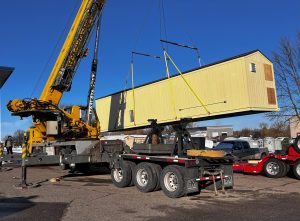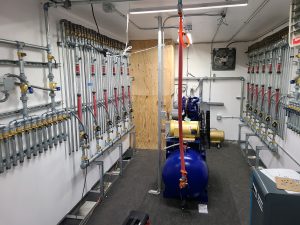Case Study: Turnkey Pump & Treat Building
A custom-designed treatment system provides vapor extraction and free product collection to maximize treatment of an underground storage tank spill.
Challenge: Provide a turnkey treatment solution for petroleum cleanup at an underground storage tank (UST) release.
An underground storage tank released about 10,000 gallons of petroleum. A remediation plan was needed to fully clean up the spill. Diesel-range and gasoline-range products tend to distribute unevenly underground and mix into the soil when spilled. The extent and type of contamination at this site required a multi-faceted, packaged treatment solution to address water contamination. This project required a complex water treatment system, close communication with environmental consultants, and strong process knowledge to effectively treat the site. H2K Technologies’ engineering team was a good match for a project of this complexity.
Underground petroleum spills can contaminate soil and groundwater, posing risks to both the public and the environment. They not only contaminate drinking water but also present serious fire and explosion hazards. Numerous approaches can be used to treat impacted groundwater, and performance is maximized when multiple technologies are combined. H2K Technologies designed and constructed a comprehensive water treatment system for this site that incorporated soil vapor extraction, air sparging, and product pumps to meet project goals.


Solution: Multiple treatment technologies combine to meet strict water treatment goals
SVE Treatment
This system used a soil vapor extraction (SVE) system to support pumping and treatment. The SVE process applies vacuum underground to extract volatile organic compounds (VOCs) from the soil. Petroleum contains hazardous substances such as benzene, toluene, xylenes, and polycyclic aromatic hydrocarbons (PAHs). These compounds easily transfer into the vapor phase when exposed to air. Extracting large volumes of air via a properly designed well field maximizes VOC transfer from underground soil into vapor. This project utilized 60 SVE lines installed in the field.
Soil conditions affect how extraction is performed. For this project, the soil was relatively tight-packed clay. A positive displacement vacuum blower was selected because it provides the high vacuum necessary for extraction in dense soils. Regenerative blowers are also common, but rotary lobe pumps are more efficient and capable of higher flows.
Vapor extraction often pulls water droplets along with air, which must be removed before main treatment. A vapor-liquid separator captures liquid droplets, maximizing blower performance and lifespan. H2K Technologies’ moisture separators and knockout tanks feature a polypropylene demister element covering the entire cross-section to minimize vapor velocity and maximize water coalescing. The tangential inlet design uses centrifugal force for efficient water/air separation.
Off-gas treatment was installed on the SVE blower discharge to eliminate VOCs before atmospheric release. An electrical oxidizer was selected; it uses high temperatures and a metal catalyst to destroy benzene, toluene, xylenes, and other VOCs. This catalytic process breaks down hazardous compounds into harmless base elements such as carbon and hydrogen. The oxidizer was critical for this project because testing revealed VOC levels well above acceptable discharge limits. This system provided high-volume extraction with safe, non-toxic discharge by destroying hazardous VOCs in the oxidizer.

Air Sparge
Air sparging is another effective method for transferring VOCs from liquid to gas and was paired with SVE in this system. A rotary claw compressor was selected for its ability to deliver higher pressure and consistent performance under load. High-pressure air delivery was important for overcoming clay-based soil resistance, groundwater hydrostatic pressure, soil backpressure, and piping friction losses. Rotary claw compressors generate high pressure air which produces high discharge temperatures. A heat exchanger was installed to cool air before it entered instruments and underground piping. The project included 60 air sparge lines that worked in tandem with the SVE lines.
SVE and air sparge systems work together to maximize treatment in the saturated zone. Clean, pressurized air is injected below the groundwater table, rising as bubbles through groundwater and soil to volatilize VOCs. These compounds are then more effectively extracted when a vacuum is applied to the SVE wells.

Product Skimmer Pumps – Product Collection
Well sampling revealed high levels of non-aqueous phase liquids (NAPL), such as gasoline and diesel compounds. Because oil is less dense than water, it floats on the water table. Skimmer pumps were installed in wells with high concentrations of petroleum products to extract them into an aboveground UL-142 tank. The skimmers, made with hydrophobic materials, selectively pulled oil while minimizing water collection.
These pumps were powered by compressed air supplied from an air compressor inside the treatment building. Fluid discharge hoses carried extracted oil to a 1,000-gallon double-wall product tank.
Water Treatment – Bag Filters & Granular Activated Carbon (GAC)
Soil vapor extraction systems frequently collect water droplets along with vapor and contaminants. High-vacuum SVE systems typically draw in significant water, making H2K’s moisture separator critical. The separator is engineered to capture 99%+ of liquid droplets and includes large storage capacity.
Data from well sampling and soil formation indicated potential for significant liquid accumulation, so the system was fitted with separator pump-out and additional treatment. Bag filters and carbon vessels were installed downstream to treat extracted water. Bag filters remove particulates to protect carbon media and extend its life. Fiberglass carbon vessels (200 lbs. reactivated carbon capacity each) were selected for an expected 10 GPM flow. A lead-lag configuration ensured maximum VOC removal while minimizing breakthrough risk. Sample ports before, between, and after the vessels allowed monitoring for breakthrough. Carbon is replaced with fresh media and vessel order is flipped after changeout to ensure the newest carbon always acts as the lagging backstop.

Enclosure & Packaging
All equipment was installed in a custom enclosure to protect components, provide service access, and allow safe operation year-round. The wood-framed 10’ W × 45’ L building included insulation, plywood walls, and a steel roof, built on a 6” structural C-channel skid base. A dividing wall separated the SVE equipment (XP-rated for explosive environments) from the non-XP controls/sparge side. Electrical components in the SVE room were designed to contain internal arcing and prevent ignition of vapors. The double-wall tank and catalytic oxidizer were installed outside the building.
All wiring was completed according to UL and NEC codes. The system was inspected by a third-party NRTL to ensure compliance. This included motor wiring, control wiring, conduit, junction boxes, and grounding. A full operational test was conducted in-shop before shipment to Texas, minimizing the need for site retrofits. H2K Technologies plumbing, wiring, and testing procedures significantly reduced site installation headaches and ensured rapid start-up.

Remote Access, Control & Notification
The system included a custom UL Listed control panel with remote monitoring and control capabilities to enhance reliability and minimize downtime. Operators and consultants could securely access the system via a web-based interface to process conditions. The remote access package also allowed authorized users to adjust setpoints, reset alarms, and trend data without traveling to the site. This functionality improved responsiveness, reduced service trips, and lowered project costs.
Automated notifications were also built in. Alarms configured to send immediate email and text alerts to designated contacts. These proactive alerts ensured that issues were addressed quickly, preventing downtime and compliance risks. H2K Technologies’ integration of remote access and notifications provided peace of mind, greater operational transparency, and the flexibility to manage the system from anywhere.


Conclusion
H2K Technologies routinely builds turnkey remediation systems like this one for underground storage tank leaks and supports projects across the United States and Canada. Contact us today our experienced engineering team is ready to help you achieve success on your next water treatment project.



